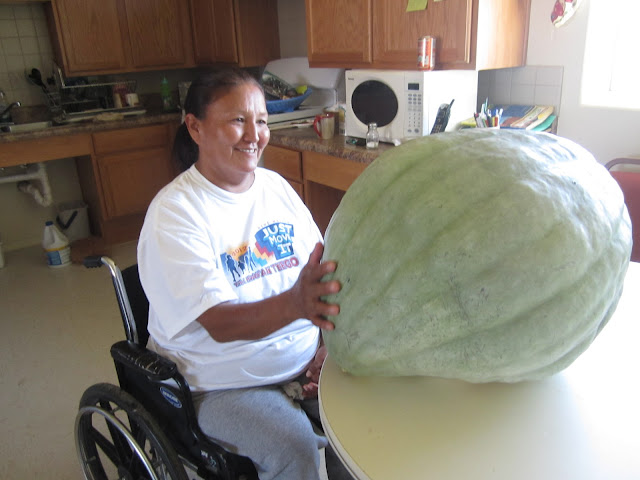There are two kinds of trees that are native to the area, the pinyon pine and what is called cedar trees but technically are probably juniper. The cedar tree has played an important roll in the life of the Navajo people. They grow on the hills around Pinon.
It is used and has been used for many purposes. One of the Navajo favorites is Blue Mush. The cedar is burned and the ash mixed with ground up Navajo corn and cooked. We see it advertised at the flea market but we have not tasted it.
In years gone by the branches were heated and put on the stomach to sooth tummy aches..
Once upon a time it provided the material for their homes but now the hogans are built of 2x4's and OSB board.
The berries on the tree were used as a food source. They were pounded into strips of meat along with other berries. They were also boiled and poured over the squash.
The dried seeds are used for beads to make ghost necklaces. They keep the evil spirits away. If you need to go to the outhouse after dark put on your necklace and you won't get scared.
When someone passes (here people don't die they pass) cedar is burned and when coming from the gravesite everyone walks through the smoke to be protected from the spirits. The cedar bough is used to brush the footprints from around the grave.
Cedar fence posts are also one of the necessary uses. Notice how they are not cut to a certain length but left however long the tree is. The posts are also used to build shades.
Several times when people visit us they ask where our stove is. We say we have a propane furnace that heats the house. They tell us that is very expensive. Here every home has a wood stove. The teacher housing does have electric heater as an alternative.
These days we are often told that "Its cold in the morning. We need to go make some woods." Above are truck loads of woods people are trying to sell anywhere from $60.00 to $150.00 a load. A young lady cut and hauled the woods in the truck in upper center and wanted $60.00 but no luck. Too close to the end of the month and everyones out of money.
Cedar trees and mistletoe. The orange colored spots are the mistletoe.
Here is a close up of the mistletoe. In the winter the mistletoe is gathered by hitting it off with sticks and it is fed to the sheep. Mistletoe is used as a medicine and also to dye wool for rug making.
 Here the mistletoe is being used for the purpose that is familiar to our culture and taken advantage of by the men. This young lady doesn't seem to mind.
Here the mistletoe is being used for the purpose that is familiar to our culture and taken advantage of by the men. This young lady doesn't seem to mind.This week we have been kept quite busy. We had a delightful experience visiting with one of our elderly members. Her health has been deteriorating for several months. Her granddaughter from Flagstaff took a year off from her college to take care of her grandmother and her herd of sheep. What a delightful young lady, so sweet and caring. To leave all the comforts to come live in a one room cabin with electricity being the only convenience and no water except to haul it over five miles from town must be a sacrifice. There are some wonderful people here.
Love to all,
Elder and Sister Lybbert
























